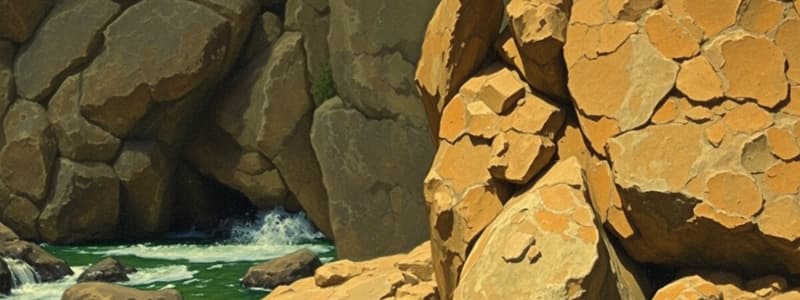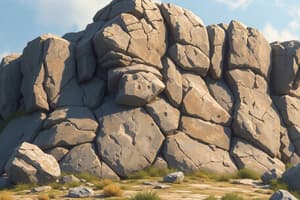Podcast
Questions and Answers
What characteristics do geologists use to identify rocks?
What characteristics do geologists use to identify rocks?
Mineral composition, color, and texture.
What are the three main groups of rocks?
What are the three main groups of rocks?
Igneous rock, sedimentary rock, and metamorphic rock.
What characteristics are used to classify igneous rocks?
What characteristics are used to classify igneous rocks?
Origin, texture, and mineral composition.
How are igneous rocks used?
How are igneous rocks used?
How do sedimentary rocks form?
How do sedimentary rocks form?
What are the three major types of sedimentary rocks?
What are the three major types of sedimentary rocks?
How are sedimentary rocks used?
How are sedimentary rocks used?
How do coral reefs form?
How do coral reefs form?
What evidence do limestone deposits from coral reefs provide about Earth's history?
What evidence do limestone deposits from coral reefs provide about Earth's history?
Under what conditions do metamorphic rocks form?
Under what conditions do metamorphic rocks form?
How do geologists classify metamorphic rocks?
How do geologists classify metamorphic rocks?
How are metamorphic rocks used?
How are metamorphic rocks used?
What is the rock cycle?
What is the rock cycle?
What is the role of plate tectonics in the rock cycle?
What is the role of plate tectonics in the rock cycle?
Flashcards are hidden until you start studying
Study Notes
Characteristics of Rock Identification
- Geologists identify rocks by examining their mineral composition, color, and texture.
Major Groups of Rocks
- Rocks are classified into three main types:
- Igneous rock
- Sedimentary rock
- Metamorphic rock
Classification of Igneous Rocks
- Igneous rocks are categorized based on:
- Origin (volcanic or plutonic)
- Texture (grain size and cooling history)
- Mineral composition
Uses of Igneous Rocks
- Throughout history, igneous rocks have been utilized for:
- Tools
- Building materials
Formation of Sedimentary Rocks
- Sedimentary rocks typically form through processes such as:
- Erosion
- Deposition
- Compaction
- Cementation
Types of Sedimentary Rocks
- Sedimentary rocks are divided into three major types:
- Clastic rocks
- Organic rocks
- Chemical rocks
Uses of Sedimentary Rocks
- Sedimentary rocks have historical significance and have been used for:
- Building materials
- Tools
Formation of Coral Reefs
- Coral reefs develop as coral animals die and their skeletons accumulate, allowing new corals to build on top.
Geological Significance of Limestone Deposits
- Limestone deposits, derived from coral reefs, offer insights into:
- Changes in Earth's surface due to plate tectonics
- Past environmental conditions
Conditions for Metamorphic Rock Formation
- Metamorphic rocks form under conditions of high heat and pressure deep within Earth.
Classification of Metamorphic Rocks
- Metamorphic rocks are classified by:
- The arrangement of grains within the rock
Uses of Metamorphic Rocks
- Metamorphic rocks serve various purposes, often in construction and art.
The Rock Cycle
- The rock cycle is a continual process driven by internal and surface forces that:
- Build, destroy, and transform rocks in Earth's crust.
Role of Plate Tectonics in the Rock Cycle
- Plate tectonics initiate the rock cycle by:
- Forming magma, which becomes igneous rock
- Causing faulting, folding, and other movements that lead to the formation of sedimentary and metamorphic rocks.
Studying That Suits You
Use AI to generate personalized quizzes and flashcards to suit your learning preferences.



